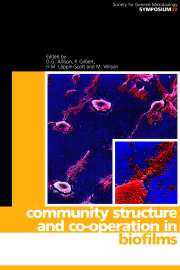Book contents
- Frontmatter
- Contents
- Contributors
- Editors' Preface
- An overview of biofilms as functional communities
- Initial microbial adhesion events: mechanisms and implications
- Physiological events in biofilm formation
- Environmental and genetic factors influencing biofilm structure
- Coaggregation and coadhesion in oral biofilms
- Cohesiveness in biofilm matrix polymers
- Microbial detachment from biofilms
- Modelling and predicting biofilm structure
- Microbial community interactions in biofilms
- Microbial communities: aggregates of individuals or co-ordinated systems
- Gene transfer in biofilms
- Population dynamics in microbial biofilms
- Biodegradation by biofilm communities
- Biofilms and prosthetic devices
- Biofilms: problems of control
- Biofilms in the New Millennium: musings from a peak in Xanadu
- Index
Microbial detachment from biofilms
Published online by Cambridge University Press: 03 June 2010
- Frontmatter
- Contents
- Contributors
- Editors' Preface
- An overview of biofilms as functional communities
- Initial microbial adhesion events: mechanisms and implications
- Physiological events in biofilm formation
- Environmental and genetic factors influencing biofilm structure
- Coaggregation and coadhesion in oral biofilms
- Cohesiveness in biofilm matrix polymers
- Microbial detachment from biofilms
- Modelling and predicting biofilm structure
- Microbial community interactions in biofilms
- Microbial communities: aggregates of individuals or co-ordinated systems
- Gene transfer in biofilms
- Population dynamics in microbial biofilms
- Biodegradation by biofilm communities
- Biofilms and prosthetic devices
- Biofilms: problems of control
- Biofilms in the New Millennium: musings from a peak in Xanadu
- Index
Summary
INTRODUCTION
This chapter reviews the broad area of biofilm detachment, the mechanisms of detachment and the methods used to study this important process. Two case studies are included: the first of these focuses on the control of clinical biofilms; the second case study examines detachment in the water industry.
Biofilms are dynamic structures found in a wide variety of both natural and man-made environments. Their formation has been well studied; for example, Characklis (1990) described eight different stages of biofilm accumulation (Table 1 and Fig. 1). There has been much research into the initial attachment of micro-organisms to surfaces, including the effect of electrostatic interactions and electrochemical forces (Bos et al., 1999). The physiological changes that attaching cells undergo have also been examined; for example, the production of surface appendages such as fimbriae (Austin et al., 1998). In contrast to the work undertaken on attachment, detachment has received little attention although many researchers regard it as a crucial stage of biofilm development (Stewart, 1993; Allison et al., 1999).
Bryers (1988) classified the detachment process into four separate groups: abrasion, grazing, erosion and sloughing. Detachment from the biofilm can be directly caused by the collision or rubbing together of surfaces on which the biofilm has developed, leading to abrasive detachment. Larger organisms feeding on the biofilm can indirectly cause detachment through grazing. Erosion and sloughing refer to physical or chemical processes, which indirectly affect the biofilm structure, leading to detachment. Erosion refers to the continual removal of cells or small groups of cells from the biofilm, whereas sloughing is the loss of discrete amounts of biofilm.
- Type
- Chapter
- Information
- Community Structure and Co-operation in Biofilms , pp. 107 - 128Publisher: Cambridge University PressPrint publication year: 2000
- 1
- Cited by



